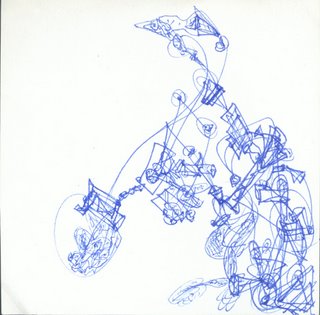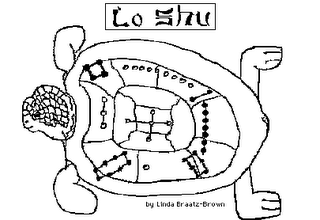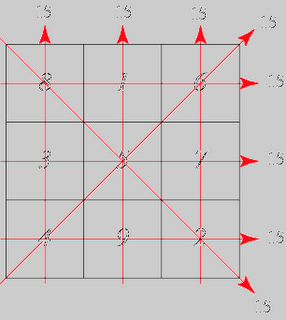Günther's Asymmetry
Letter from Prof. Dr. Gotthard Günther to
Prof. Dr. Rainer Wiehl, from 8.12.78
"... A. Gehlen that all main culture is in principle script culture... "
"...strange, so far not solved phenomenon of the Chinese culture...in pre-Christian time admit that there are also alphabetic scripts, which can in principle be much more simple, cleared away and remained with ideograms.
In addition a further fact. There are all in all, to which also late characters excluded from taboo reasons, belong approximately 70000 ideograms. In addition however the classical north Chinese contains of only about 500 out-speakable words. In south Chinese there are perhaps 800 or 900, so that on speakable words, even if one counts only the ideograms in use, hundreds of ideogrammatic characters come.
That is, in holding to the ideograms, lies an unconscious insight of a massive asymmetry between spoken and written language.
It is the written language, on which a main culture rests.
It possesses an identity strength, which stands out clearly against the identity weakness of the spoken word. The Chinese are not in vain the socially most stable people in the past main cultures. They would not be it without this holding to a system, which seems to have disadvantages only for the progressive European.
Now the title of my work in Belgrade is "Identity and Counter-Identity" - i.e. the universe is a complexion of temporal character, in which an identity develops into a counter-identity. In doing so the universe necessarily has to pass through an epoch of ontological identity weakness.
The subjectivity of humans particularly, but generally all subjectivity, are ontological places of identity weakness, which in the long term cannot hold themselves.
That becomes understandable, if one realizes that one can exchange the words object and subject with the pair of opposites, symmetrical and asymmetrical systems. Only symmetrical systems have a certain stability.
Souls are from the beginning designed on dying, because they are expression of total asymmetry. There is no more powerful asymmetry than those, which lies in the contrast of I and world.
The Chinese failed at the role to liquidate the actual epoch of the main culture, because they tried to develop the much more powerful negative language before they possessed a positive language practically completed in Occidental mathematics.
That cannot be done for purely technical reasons, if one brings to mind oneself the beginnings of the negative language, as I indicated them in the Heidegger essay.
In this premature adherence to the ideogrammatic negative language, China swam against the current of world history, and Europe went in the opposite attitude with history." (translation, kae)
===
Decision against Alphabetism?
Gotthard Günther then asked the Sinologist Engelbert Kronthaler,
"When did the Chinese consciously decide against the introduction of alphabetic writing?"
Kronthaler answered this question some years later at 28.3.1979.
His answer was published in semiosis, 1980 in German language.
SUMMARY
"The point at issue is G. Günther´s question as to when the Chinese consciously decided in favour of visual script and against phonetic script. Alphabetical and ideogram scripts are not only various steps of development of script, they are two types, each on the pinnacle of different lines of development. The alternative phonetic script/visual script reflects the different world view of West/East, speech/script. In both, the relationship speech/script is equally evident, it is however subject to a different primacy. The conversion from the one to the other would be more than just a change of script, of apparatus, it would essentially be the change of conception, would be connected with the abandonment of the other, and would, therefore, as a whole be a reduction of complexity which must be rejected." E. Kronthaler
Chiastic Dynamism
Gunther understands the universe as a "complexion of temporal character, in which an identity develops into a counter-identity".
In contrast to the Heraklitian dynamism the Chinese dynamism is complex, parallel, concurrent, co-creative, i.e, chiastic. It is not only connected with temporality in the Western sense of linear time, but with space and spacing (making space). And this is exactly what Gunther is developing. In his lifelong search to incorporate time into logic (and arithmetic) he was forced to offer time its own space, i.e., time needs an own structural locus. Otherwise, time is ontologically subordinated to Being and Nothingness.
Loci are not in the mind (of a thinker), they are in the world. The mind is occupying only one locus in this grid of loci.
The big difference of Gunther’s approach to chiastic dynamism or dialectic cosmology to other approaches lies in the fact that he tried and partly succeeded to implement it into operative formalism. Without that it would be something like a continuation of the tradition of notional narratives.
The French philosopher Alexandre Kojeve told me, when I was driving him in West-Berlin with my Italian car to his hotel, that everything to be said had been said. The only thing to do now is to do something now. I tried to confront him with the mathematics of the Gödel proof. But this was obviously not good enough, probably because it was also only a book, again.
Next epoch
In doing so, the universe necessarily has to pass through an epoch of ontological identity weakness. Which was, after Gunther, the Western epoch.
This epoch is defined by Western philosophy, science, technology and economy based on alphabetism.
There are good reasons to think that this epoch has come to a closure.
Gunther is not saying in his letter that the next epoch will be necessarily Chinese. But he says that the Chinese thinking, mediated by its script, has an "identity strength" not existing in the Western world. But China has not (yet) developed an operativity correspondig to the complexity of its writing paradigm. This kind of operativity is proposed by the Guntherian project of a "negative language".
We shouldn't supress the thougth that a form of intelligence, not bounded and resricted by terrestrian conditions and able to communicating with human beings, would probably posses a more stable "identity strength" than any terrestrial cultures.
--
(blog-test version)



